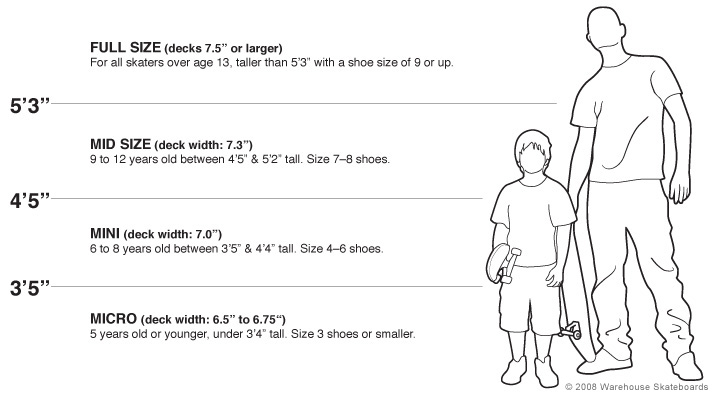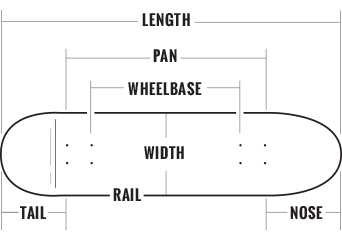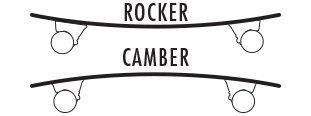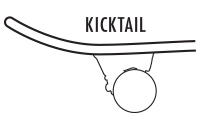Choosing the Right Skateboard Deck
There are a lot of different parts on a skateboard, but one of the most obviously important is the skateboard deck. The skate deck is the flat board that you stand on when skateboarding. A shortboard, as opposed to a longboard or cruiser, is ideal for street skateboarding and vert skateboarding. It also remains the very best option for doing tricks, whether you are a beginner or a pro.
There are a few things to consider once you decide to build a complete skateboard, and picking the right size of deck is the first of many choices you'll make. Choosing board shape is also super important. The length, width, materials, and concave of your skateboard deck determine what you will be able to do on your skateboard.
Depending on how hard you skate, you'll want to replace your skateboard deck anywhere from after a few weeks to a year. Once the sides, nose, or tail of your skateboard deck show signs of splitting, it's time to start with a fresh board. Riding in wet or cold areas can also warp the shape of your board and make your skateboard wheels uneven, so be sure to replace your board if you feel or see any signs.
Warehouse Skateboards offers a huge selection of skateboard decks in a variety of shapes, sizes, weights, colors, and patterns. Check out our inventory to find the skateboard deck that suits your style.
What size skateboard do I need?
What Size Board do you Need? Find Out.
Contrary to what you might think, width is the most important part of choosing a skateboard deck, not length or wheelbase. Skateboard decks vary in width from 7.5" to 8.25". The width you need depends on your height, shoe size, skating style, and personal preferences.
If you choose a board with a too-large width for you, you will need to exert excessive power, which can make skateboarding and trick riding difficult. If you choose a board with a too-small width for you, you'll have trouble balancing and won't feel stable. Most teen and adult riders will want at least a 7.5" width, but a wider board may feel more stable depending on your build and shoe size. Below are some general guidelines.

7.5" to 8" - Standard board for adult riders skating streets or doing more technical tricks
8.0" to 8.25" - Skating pool, ramp, rail, and parks
8.25" and larger - Vert, pools, cruising, and just going old school
Top Selling Decks
Choosing a style of skateboard deck
If you're just getting into skateboarding, it will be helpful to familiarize yourself with the different styles of boards that skateboarders use. Skateboards come in four basic shapes. Each style of deck is designed for certain kinds of skateboarding, so the board shape you choose should match the style you want to skate. From there, you can build a custom complete using components that match your skateboard deck and skating style.
Shortboard
Shortboards are the shortest style board and are designed and shaped for getting air and performing tricks. If you're leaning towards street or park skating, a shortboard style deck will be a perfect match for you. Check out our shortboard skateboards selection.
Cruiser
Cruiser boards often have kicktails, but are more designed for simply cruising around. The decks are typically mid-length. Cruisers are versatile and maneuverable, making them good for cruising the streets. Check out our cruiser skateboards selection.
Old School
Old school boards typically have a flat nose and kicktails. They are usually asymmetrical, with a wider nose. Old school boards are an awesome choice for skating pools, ramps, or carving the streets. Check out our old school skateboards selection.
Longboard
If you're not interested in doing tricks and want a skateboard to push around on for transportation, longboard skateboards, or cruisers, are a great option. Some longboards are specifically designed for downhill racing. Downhill longboards tend to have a symmetrical shape, sit lower to the ground, and have wheel cutouts, which allow larger wheels to be used. To find out more about cruiser longboards, check out How To Buy A Longboard and browse our longboard decks.
Popular choices for skateboard decks are Element skateboard decks and Zero skateboard decks. These skate decks are well made, stylish, and available in a variety of styles.
Features of skateboard decks

Skateboard decks vary in size but most are between 7"-10" wide, and are made of seven-ply wood, bamboo, resin, carbon fiber, or plastic. Deciding which skateboard deck is best for you depends on what you will be skating and, of course, your personal brand preference. Below are some factors to consider when buying your skateboard deck.
Width
Choose your skateboard deck according to the width, not length. The average width of a skateboard deck is 7.5"- 8.25". The right width depends on your size and skateboarding style. If you buy a deck that is too wide for your height and shoe size, you will need to exert more power, which can make skateboarding and trick riding difficult. If you choose a board that is too narrow for your height and shoe size, you'll have trouble balancing and won't feel stable. Generally, teen and adult riders will want at least a 7.5" width. Larger skateboarders and those skating ramps and vert ramps should go with a wider deck, and street skaters usually need a smaller deck.
Length
Skateboard length is the distance from the tip of the nose to the tip of the tail. Shortboard length falls between 28"- 32" but only advanced skaters refer to length. Width and wheelbase should be top considerations when building your skateboard, rather than length.
Wheelbase
The wheelbase is the distance between your board's inner mounting holes. The distance between these mounting holes determines how far apart your front and back wheels will be. Manufacturers determine wheelbase by where they drill the truck mounting holes on the deck. The average wheelbase is 13"-15". Although many decks only feature one set of holes, some skateboards have multiple mounting holes for trucks (or "wheelbase options"). Adjusting wheelbase can dramatically affect how the board performs. Your experience level will indicate the right wheelbase for you.
Nose and Tail
The nose is the "front" of your skateboard and the tail is the "back." Which end is which can be hard to differentiate, but most decks provide you with graphics to tell the two apart. Many skateboard decks have a bigger kick on the nose and mellower kick on the tail.
Mounting Holes
Mounting holes are pre-drilled holes where the skateboard trucks are attached. Arranged as two sets of four holes; one set is near the nose, the other near the tail.
Ply
Ply is the thin levels of wood that are tightly pressed together to make the skateboard deck. Rather than making a deck from one solid piece of wood, most manufacturers layer the wood in a cross-grain pattern to create a supremely strong board. The typical skateboard is seven-ply, and most boards aren't over nine-ply.
Concave
Concave is the curve of the wood between the deck's nose and tail. Concave allows a more controlled ride and a stronger skateboard. Read our concave guide below for more information about different concave shapes.
EFP
EFP is short for Effective Foot Platform. Unlike wheelbase, which measures only distance, EFP describes the area on the topside of the deck that riders stand on to control the board. EFP indicates the part of the deck between the front and rear trucks. You can think of EFP the space of a skateboard deck that isn't the nose or tail.
Rails
Rails are the edges along the length of your board, and their shape can make a difference in how your board rides. Rounded rails are common for skateboards, and their shape makes them good for flip tricks. Sharp rails have a blunt edge, which keep your shoes securely in place during slides. Gas pedal rails (or GPs) are a specialized rail shape where areas of the rails have been cut to a beveled edge. GPs subtract the rail's sharpness, and decrease the concave. Gas pedals give you better control and comfort when doing slides. What your rails can do also depends on the concave of the board.
Skateboard concave shapes
Concave is a major factor in board performance. Skateboard manufacturers are always experimenting with new concave shapes to accommodate new types of skateboarding. Most concave shapes allow riders more foothold than a flat skateboard, which can take sliding, drifting, and turning to the next level.
Camber & Rocker

The lengthwise curve of your skateboard deck also plays a role in how the deck feels and what kind of skateboarding you can do on it. Skateboard decks with a raised middle are known as camber skateboards, and those with dropped middles are called rocker skateboards. The angle of camber and rocker is typically mellow, but even the subtle difference in shape can affect the flex of your board.
The majority of skateboard decks have a neutral deck camber (not to be confused with deck concave), though some cruisers and longboards feature camber-style decks. In decks with positive camber, there will be much more flex because of the higher center of gravity. Rocker decks have a low center of gravity, and many riders find the sloped shape more comfortable to stand on. The minimal flex makes rocker boards a good choice for carving and going downhill at high speeds.
Kicktail

The upward curves on the ends of your skate deck are known as kicktails. If you plan on doing any tricks on your skateboard, you will need a deck with kicktails. Kicktails makes it possible to ollie, which is the first step to the vast majority of skateboard tricks. Most decks have kick on both the nose and tail, which allows for even more advanced skate tricks. Kicktails and kicks are also important for sharp turns, pivots, slides, and general maneuvering in street skating.
Some longboards also feature kicktail, although it is usually mellow. Most riders don't do advanced tricks on their longboards, but kicktails still help during turns, and lifting the front trucks over sidewalk cracks and debris.
Skateboard decks construction
Before you learn to master riding your skateboard, it's a good idea to learn how the skateboard deck is actually constructed. Though manufacturers tweak their processes to achieve specific results, the basic steps and materials have remained the same for decades.
Maple wood is an ideal wood type for skateboards; it is flexible, yet durable, allowing it to be easily shaped without sacrificing strength. It's still the most common material used for skateboard decks. Even within maple decks, the amount of ply can vary. Ply is the measure of how many thin sheets, or veneers, of wood make up the deck. These wood veneers together actually make for a stronger board than a single, solid plank. The most common construction is 7-ply, though decks may increase or decrease veneer to either increase strength or decrease weight.
Constructing a skateboard deck begins with placing the veneers on top of one another. Beyond the amount of ply, the direction the wood grain is facing can make a big difference in the board's performance. Alternating between veneers that run lengthwise and veneers that run widthwise, or cross-beaming, can increase the board's durability. Once the veneers are glued into place, they are formed under a hydraulic press, which compresses the wood layers into a single, sturdy strip. This is also the stage of the process where the unique nose, tail, and concave of the board are formed--the press bends the wood layers into shape. The board is left in the press while the glue sets, and this too can play a part in the board's ultimate performance. The longer the glue sets, the more naturally the board is held together.
Next, holes will be drilled into the deck to allow trucks to be attached. From there, a band saw is used to cut the deck's shape from the large piece of formed wood, which is then rounded and sanded smooth. The deck is also varnished and sealed to protect the wood against warping and getting damaged. Lastly, manufacturers will add graphics to the deck. Many skateboards are screen-printed, though some companies offer custom hand painting as well. The skateboard deck will dry and set in the factory until it is ready to be sold.
The art of skateboard manufacturing has been refined over the past few decades, and manufacturers are constantly experimenting with new technology, materials, and graphics trends.
Check out our massive selection of skateboard decks.
For more information on skateboard decks and other components, check out How To Build A Skateboard.
Still have questions?
We are Warehouse Skateboards. Our goal is to provide you with great customer service and information to make an informed skate purchase.
Give our customer service team a call at 877-791-9795. They will help you find the right products to fit your skateboarding needs. Still have questions? Please fill out our simple contact form.